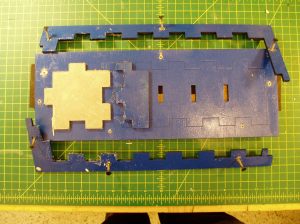to make this project successful and achieve the aggregating panels….
Additional Materials
- vaseline (no saran wrap needed as previously listed)
Improved Procedure
- lasercut the formwork and ’stops’
- Screw the layers of the form to a sturdy piece of backing material (don’t glue!)
- set the appropriate ’stops’ into the form for your desired piece
- coat the area with vaseline, apply like caulk to corner joints for easy release
- mix + pour rockite into mold
- allow to dry completely (more than the 15 minutes listed)
- unscrew formwork and pull it away from the cast panel
Design Improvements
I divided the formwork into 2 halves that could be screwed in place or slid away from the cast panel. This way, the panel could be removed from the machine without destroying the rockite!
New Process
1) I lasercut the improved form and spraypainted it blue in high gloss paint so it could be sealed. Then coated it in vaseline as a release agent.
2) this is where the form comes apart, and screws together again.
 3) Here’s how the form breaks away from the cast panel.
3) Here’s how the form breaks away from the cast panel.
4) First 3 successful panels out of the machine. One has the slot for perpendicular attachment in aggregation. (one was too soft when i took it out so it was quickly patched with leftover rockite)
 6) Finally, 3 panels forming structure in X,Y,Z directions…. lots of potential!
6) Finally, 3 panels forming structure in X,Y,Z directions…. lots of potential!



